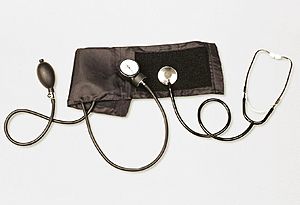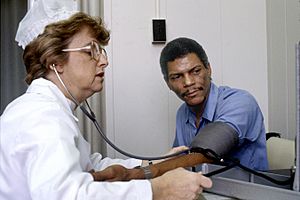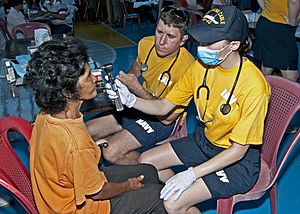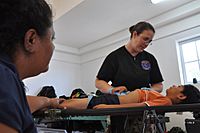Nursing assessment facts for kids
Nursing assessment is how nurses gather important information about a patient. This includes checking a person's body, mind, feelings, and even their spiritual well-being. It's the very first step a nurse takes in helping someone.
Think of it like a detective gathering clues! Nurses collect facts to understand what a patient needs now and what they might need in the future. They look for what's normal and what's not. This helps them figure out the best way to help. Sometimes, parts of this job, like checking vital signs (like temperature or blood pressure), can be done by other trained helpers.
Talking with Patients: The Interview
Before a nurse can start checking things, they need to talk with the patient. This first chat is super important! It helps the nurse and patient build trust. The patient needs to feel comfortable sharing personal information.
A nurse will usually introduce themselves first. Then, they'll ask the patient how they prefer to be called. They'll also explain what they'll be talking about.
Nurses change how they talk depending on who they're speaking to. They might talk differently to a young child than to an older person. They also make sure the patient has privacy and no distractions. They avoid using complicated medical words. Instead, they use words the patient understands.
During this first talk, the nurse tries to understand the patient's main concerns. Sometimes, they need to do a full check-up. Other times, they focus on just one problem. For example, if someone has a stomach ache, the nurse will focus on that.
Nurses often use a special checklist called OLDCART to remember what to ask about a problem:
- Onset: When did the problem start?
- Location: Where on the body is the problem?
- Duration: How long does it last?
- Characteristics: What does it feel like? (e.g., sharp pain, dull ache)
- Aggravating factors: What makes it worse?
- Relieving factors: What makes it better?
- Treatments: What has been tried to fix it?
Learning About a Patient's Past
Getting a patient's history is like hearing their story. It's what the patient tells the nurse. Even though it's what someone says (subjective), it's very important. Nurses combine this story with things they can measure (objective facts).
Good nurses ask "open-ended questions." These are questions that can't be answered with just "yes" or "no." For example, instead of "Do you have pain?", they might ask, "Can you describe your pain?" If the patient can't answer, family members or caregivers can help.
Nurses usually ask about these things:
- What is bothering you now?
- When did it start?
- How bad is it?
- Is it a new problem or an old one?
- Your past health problems.
- Health problems in your family.
- Your daily life and habits.
- What medicines or treatments you are getting.
- What you understand about your health plan.
- How you feel about being sick.
Nurses also look at test results, like blood tests or urine tests. They check old medical records too. This helps them see what's normal for that patient.
Sometimes, in emergencies, nurses don't have time for a long talk. They focus on making sure the patient can breathe and has good blood flow. This is called triage. It happens in emergency rooms. If someone is in a lot of pain, that's the first thing the nurse will help with.
Checking the Body: Physical Exam
A big part of nursing assessment is the physical examination. This is when the nurse looks at, touches, and listens to the patient's body. They check for "signs" (things they can see or measure, like a rash) and "symptoms" (things the patient feels, like nausea or dizziness).
Nurses use different ways to check the body:
- Inspection: Looking closely at the body.
- Palpation: Gently touching the body to feel for things.
- Auscultation: Listening to sounds inside the body, like with a stethoscope.
- Percussion: Tapping on the body to hear sounds.
They also check "vital signs":
- Body temperature
- Blood pressure
- Pulse (heart rate)
- Respiratory rate (how fast someone breathes)
Nurses also check different body systems, like the heart and blood vessels (cardiovascular system) or bones and muscles (musculoskeletal system).
Focused Checks
Sometimes, nurses do a "focused assessment." This means they look very closely at one specific area or system.
Checking Nerves and Blood Flow
Nurses check the arms and legs to see how well the nerves and blood vessels are working. They feel for pulses, check how fast blood returns to the skin (capillary refill), and look at skin color and temperature. They also check if the patient can feel things and move their muscles. They compare one side of the body to the other.
Checking Mental State
Nurses also check how a patient's mind is working. They look at:
- If the patient knows where they are and what day it is.
- Their memory.
- Their mood (happy, sad, worried).
- If they are seeing or hearing things that aren't there.
- How they speak (clear, fast, slow).
- How they look (clean, dressed properly).
- How they react to sounds or touch.
- How alert they are.
- Their posture and how they walk.
Checking for Pain
Even though pain is not called a "vital sign" anymore, checking for it is still very important. Pain is different for everyone. Nurses need to understand what makes pain better or worse. They ask about:
- What causes the pain.
- What makes it feel better.
- What the pain feels like (sharp, dull, burning).
- Where the pain is.
- How bad it is (often using a scale from 0 to 10, or a face scale for younger kids).
- When it started, how long it lasts, and how often it happens.
Checking Skin, Hair, and Nails
Nurses check the skin, hair, and nails for clues about a person's health. They look at:
- Hair: How much there is, where it grows, and its texture.
- Nails: Their shape, color, and if they show any problems.
- Skin: Any rashes, cuts, or sores. They note the size, color, and if anything is draining. They also check skin texture, moisture, color, and how stretchy it is.
Checking the Head
Nurses also check the head area:
- Scalp and face: Looking for symmetry and checking sensation.
- Eyes: How well someone sees, eyelids, tear glands, and the white part of the eye. They also check pupil size and how they react to light.
- Ears: The outer and inner ear, eardrum, and how well someone hears.
- Teeth: Checking their condition.
Understanding Feelings and Life: Psychosocial Assessment
This part of the assessment looks at a person's thoughts and feelings. Nurses check:
- How well someone thinks and understands things.
- If they have hobbies or interests.
- How they feel (sad, happy, angry) and what they do about those feelings.
- Their beliefs and religion.
Nurses always consider if a physical problem might be causing mental changes.
Checking for Safety
Nurses also look at the patient's surroundings to make sure it's safe. They check if the patient needs help walking, like with a cane or walker.
Understanding Culture
A patient's culture can affect their health and how they want to be cared for. Nurses ask about:
- Where the patient's family comes from.
- What languages they speak.
- If they need an interpreter.
- Who their main support people are.
- Who makes decisions in their family.
- Their religious beliefs and practices.
- Any special health beliefs or practices.
- How they usually react to things like pain or fear.
- Topics they might not want to discuss due to cultural reasons.
- Their feelings about touch or eye contact.
- Any health problems common in their cultural group (like lactose intolerance in some groups).
- Any foods they ask for or refuse because of cultural beliefs.
Tools Nurses Use
Nurses use many tools and checklists to help them. Some tools help check how well a person can do daily tasks, like dressing or eating. Others check for specific risks, like the risk of getting a pressure sore. The Glasgow Coma Scale helps nurses check how awake and aware someone is. There are also different pain scales to measure pain.
Nurses also use medical equipment during their assessment:
- An otoscope (to look in ears)
- A thermometer (to check temperature)
- A stethoscope (to listen to heart and lungs)
- A penlight (for checking eyes)
- A sphygmomanometer (for blood pressure)
- Eye charts (for vision)
Besides talking, nurses use their senses: observing, listening (auscultation), touching (palpation), and tapping (percussion) to gather information.
See also
 In Spanish: Valoración de enfermería para niños
In Spanish: Valoración de enfermería para niños






